Stinkwort along I-280 at the Page Mill Road exit in Palo Alto.
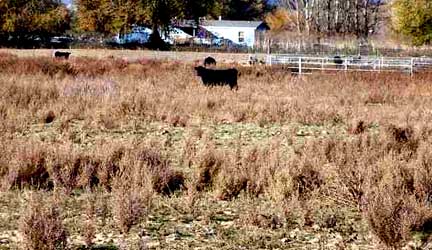
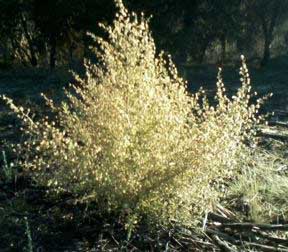
The STINKWORT (Dittrichia graveolens) can be our best teacher of grassland ecology or the worst weed ever, depending on what side of the California grassland fence you are on. --Are you maintaining exotic grasses in California for hay and grazing or are you restoring the original California native bunchgrasses and wildflower meadows?
Copyright text and photos © 2013, 2017, 2018, 2024 by Craig Dremann, The Reveg Edge, Box 361, Redwood City, CA 94064 (650) 325-7333
The Stinkwort was first noticed in California in Santa Clara County less than 30 years ago. The infestations on the San Francisco Peninsula are mainly spreading along the roadsides, and in 2017, this new weed has not been yet regularly eradicated each summer and autumn by any road management agencies, like those of Towns, Cities, County road crews or Caltrans highway maintenance crews..
Now that this new weed has spread to infest more than half of California's counties, government agencies could start paying attention, especially since this noxious weed is showing up in the Napa County vineyards and there are concerns that the plant might give an off-flavor to the wines. And horse owners are noticing the weed starting to infest their pastures.
Also there are concerns about the plant going
into the rangelands of the State, and injuring stock.
BLM on their web site has issued the following notice:
Warning!
Touching stinkwort can cause dermatitis, itchy skin, or blistering.
Grazers that eat this plant can produce tainted milk or meat.
When the seeds are ingested by grazing animals they can cause
inflammation of the small intestine, and can lead to pulpy kidney
disease or sudden death.
Stinkwort is a California native tarweed-mimic, in that it has sticky stems and leaves and grows and flowers in the summer, after the annual weed grasses have died for the year.
After 1865, when the perennial native grasslands were largely grazed to dust during the two year drought (William H. Brewer's accounts), then the non-palatable native plants like the tarweeds flourished in California between the 1870s to the 1920s.
The density of the tarweed in the 1920s in California grasslands can be seen in photos taken by Frederick Clements when he worked at Stanford at the Carnegie Institution. Since that time, ranchers have worked diligently to exterminate the native tarweeds and the other summer-blooming native wildflowers from rangelands.
Tarweeds were probably largely wiped out after the invention of herbicides in the 1950s, so since the 1970s have been absent in 99% of California grasslands, and over a dozen species are in such low numbers, that they are Listed as Endangered Species.
Now, this exotic tarweed-mimic arrived, spreading quickly to fill the empty ecological niche left by the essentially extinct native tarweeds and other summer-blooming native plants. Stinkwort has now put a spotlight on the last 200 years of grassland mis-management in California.
When the original California native grassland
was exterminated, it included many tarweed species and other summer-blooming
members of the sunflower family like the Golden Aster (Heterotheca),
the Gumplants, the beautiful Lessengia and many others. Also
other summer-blooming native plants like the Buckwheats, Wild
Licorice, Spanish Clover, plus the Milkweed plants that are
needed by the Monarch butterflies to survive.
The Europeans who introduced the palatable exotic grasses that
were useful for grazing, plus the exotic filaree and exotic clovers
and vetch species, were hoping that these exotics would be the
only plants to replace the now mostly extinct native bunchgrasses
and wildflowers.
However, an ecological rule is--When you exterminate an entire native grassland ecosystem and converting it to an exotic-plant biome, it is impossible to have fields of only the desirable wild oats and not expect the weedy exotics like Medusa head grass, Stinkwort and Yellow star thistle to follow. You cannot have the desirable filaree without the potential of having Stinkwort, Cheatgrass, or Italian thistles for example.
So, the battle begins for the empty tarweed ecological niche in California. If you are growing grapes for wineries, or grazing lands now covered with exotic grasses, or trying to maintain weed-free roadsides, or want to have a horse pasture without poisonous weeds, expect to need to have some annual Ecological Restoration budgets to keep Stinkwort from filling in that now-empty tarweed ecological niche.
Stinkwort's almost magnetic attraction to the open tarweed niche, plus the dandelion-like seed pappus allowing it to blow in the wind, will help this plant to eventually become perhaps one of the most hated weeds in California or maybe the worst weed in the Western United States.
However, if you are doing Ecological Restoration of the native bunchgrasses and wildflower fields, then this new weed could help, to grade your projects. Stinkwort, wherever it grows, will indicate where you still have some more work to do on that spot of land, to fill in all of the proper native grassland ecological niches and puzzle pieces.
Stinkwort's LOVES and DISLIKES--
Stinkwort loves poor soil where
other plants cannot grow, like in the gravel roadsides where there
are not enough nutrients or organic matter for anything else to
grow.
Stinkwort loves areas where summer native wildflowers do not grow, like the tarplants, gumplants, Spanish clover and other summer-blooming plants grow.
Stinkwort loves where it has no plant competition, like in the summer, dry annual weed grass areas, or grazed meadows and fields like horse and cattle pastures.
The easiest way to get rid of stinkwort, is make the area into an area that it dislikes--have the native summer blooming plants grow, add the organic matter and fertilizers so something else can grow. That will be the only permanent fix.
Temporary fixes could be hand-pulling, mowing and herbiciding, but those will never be permanent, and eventually everyone will need to do the Ecological Restoration needed to convert back to natives to keep the stinkwort permanently out.
Stinkwort as a "Public Nuisance"
The Stinkwort was put on the State Noxious weed list, which means that it was automatically declared under law, to be a "public nuisance". So then, the Food and Agriculture codes giving the County Agriculture Commissioners the power to issue abatement orders to stop the infestations of this new weed from spread from property to property.
The Stinkworts have been making their way up the San Francisco peninsula, following Caltrans roadside up US 101 and I-280, then started moving across the Peninsula along East-West highways like 92 from US 101 to the Coast Highway One. Then, these roadside infestations of scattered plants along the freeways, start spreading downwind in a cone-shaped pattern to start large infestations. It looks like small fires getting started, and then in turn, throwing embers downwind, to start larger fires.
The Towns of Los Altos Hills, Palo Alto and Stanford have the largest infestations so far when a survey was done in 2017. The Stinkworts growing along nearly every roadside in the Town of Los Altos Hills, and several multi-acre infestations on the Stanford Hills between I-280 and the Dish, thick along the trails off Foothills Expressway and also on either side of the SLAC building, getting into the Jasper Ridge preserve, and also getting started in the middle of the 100+ acre Woodside Horse Park along Sand Hill Road. The infestation in the old Palo Alto baylands dump, is providing a home for the weed in that area.
On the SF Peninsula, all of the remaining native grasslands are threatened, especially the serpentine grasslands with many rare and Listed Endangered plants and insects that live between Palo Alto and the Crystal Springs reservoirs, plus the grassland habitat with their Endangered species on San Bruno Mountain.
In the Stinkwort's cross-hairs are Jasper Ridge at Stanford, Edgewood Preserve, SFPUC serpentine grasslands along the Crystal Springs lakes, and the grasslands of San Bruno Mountain. Also all of the horse pastures of the Town of Woodside and Portola Valley will be vulnerable in the future.
Three of the Mid-Pen. Open Space preserves, Monte Bello, Rancho San Antonio, and Fremont Older are already infested, according to the Calflora database. And, in the fall of 2017, the stinkwort plants are seen growing along Skyline Blvd. (Highway 35) within a few feet of three other Mid-Pen. preserves, Skyline Ridge, Russian Ridge and Windy Hill.
Stinkwort plants growing along the coast at Pilar Point were photographed October 31, 2017 and that location was recorded in the Calflora data base, as was another occurrence near Montara, so that means all of the grassland habitats along the Highway One are also vulnerable.
So how can annual fund be put together, to do ecological restoration of the infestations on the SF Peninsula?
Caltrans recognized the infestation at the interchange of I-280 and San Hill Road was helping spread the weed elsewhere. First, they tried mowing and herbicides, and the stinkwort just laughed at that weak response. Then, Caltrans tried the "Scorched Earth" method, by spending tens of thousands of dollars pouring concrete on that infestation. And now, the stinkwort still spouts and grows very happily in the gaps in those poured concrete slabs.
FINAL Stinkwort FIX. Bulk native seeds could be sown to fill in the empty ecological niche, and keep out the Stinkwort, the Yellow star thistle and any other weeds that are currently taking advantage of that empty niche.
And doing soil tests in adding the organic fertilizers and mulch that the native seedlings need so they can replace the stinkworts in the future.
Budgets to sow native seeds? A significant portion of the native seeding budget needs to be set aside, in order to hire professionals in Ecological Restoration to start sowing native seed seeds, along Caltrans roadsides, and within the public grassland preserves like Edgewood Preserve, or the SFPUC watershed. And to convert all of the infestations on private lands, back to native plant and summer blooming wildflower cover
Annual budgets to do soil tests, and add the fertilizers and organic matter needed by the natives? Stickwort's main rule, is that it grows in soil that is too poor for the local native plants.
Therefore, annual soil tests for stinkwort infestation, and then testing the soil from nearby stands of wildflowers, can show what needs to be added to get the wildflowers to grow in the place of the stinkworts.
And then, budgets to pay for the necessary organic fertilizers and organic matter, need to be put together. On a Town-wide scale, like the Town of Portola Valley, each homeowner could send an annual check to the Town as a tax deductible donations, for an Ecological Restoration fund. This fund could do two things, convert the stinkwort and also start to convert the other flammable weeds, back to fire safe wildflowers.
Each year, there is still a threat of wildfires caused by the mowed weeds grass straw, still on the ground. After the annual mowing of the weed grasses by San Mateo County, Palo Alto and Portola Valley of their open spaces in late spring, there are still thousands of pounds of flammable mowed straw on the ground that could burn hotter than 1,000 degrees F.
Each summer, at the La Honda's County-owned six-acre slide = 16,000 pounds of mowed straw per acre. Palo Alto Arastradero Preserve = 17.000 pounds per acre. Portola Valley's Frog Pond and Spring Down Meadow = 7,000 pounds per acre.
An annual $1,000 tax deductible donation check from each homeowner in Portola Valley, would mean a $2 million budget for invasive weed management and making the town more wildfire resilient in the future.
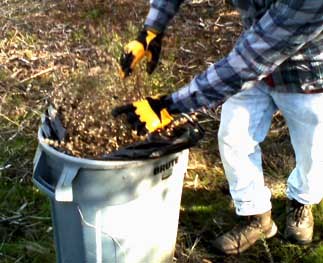
STOP-GAP hand removal of small infestations - I did an experiment on December 9, 2017 on a 500-plant infestation. Before it rains, you need tree branch lobbers to be able to cut the thick tough stems at their base. However, after the rains have moistened the ground, and the plant turn from green to tan, they can easily be hand pulled. On this date, most of the seed were still attached to the plants.
We hand-pulled the 500 plants, carefully put them in piles, then took a 33 gallon plastic garbage can and lined it with a tough 33 gallon trash bag. By folding the plants over the can, any loose seeds would fall into the can as we stuffed the plants to fit into the can. About 100 plants can fit into a 33 gallon trash bag, and about 200 plants per hour can be hand pulled and bagged per person.
The next issue comes up--what to do with all of these hundred of thousands of ripe Stinkwort seeds--green waste bin or black trash bin. If it is put into the green waste bin, then it must be take out of the plastic bags, and when dumped into the truck, could fly out of those open truck tops, and scatter itself along the highways like Johnny Apple seeds sowing.
That is the only method I can see, how the entire length of Hwy 92 got totally infested, that is the route that the dump trucks take to go from the transfer station in San Carlos, to the landfill site near Half Moon Bay at Ox Mountain. So maybe the best method is to keep it in the plastic bags, so it does not distribute seeds on the way to the landfill?
Hand-pulling with volunteers or prison labor, should never be considered by open-space, park or roadside managers, because this weed is moving much to quickly to get the job done using unpaid labor.
Instead adequate budget need to be put together
each year, so that your agency can get out every summer and eradicate
every plant on your property, and get them replaced with a local
native summer-blooming wildflower to permanently fill in that
ecological niche.
BAGGING and KILLING the seeds.
Fortunately during dry weather in fall to winter, the Stinkwort plants still retain a lot of seeds on them, so during the dry spell on December 9, 2017, my crew carefully cut and bagged 500 plants, and we invented methods to hand-manage plants while they are still full of seeds, and before the rains.
-- CUTTING and PULLING PLANTS--For large plants, use heavy duty tree branch lobbers, and cut them at the base. For smaller plants, after the rains have softened the soil, those plants can be hand-pulled.
-- 33-GALLON GARBAGE CAN and BAGS--Get a 33 gallon plastic garbage can, and line it with double heavy duty plastic trash bags. Wearing gloves, the plants can be folded in half or thirds to fit into the garbage can, and if any seeds are shed in the process, do your plant-folding over the open garbage can to catch any the drop.
You double-bag the garbage bags, because the stem ends can sometime tear though a single bag.
--#64 RUBBER BANDS to SEAL BAGS--You can then crush the plants into the can, and tightly seal the end when the bags are full. It might be easiest to use large rubber bands to seal the ends of the garbage bags, using the #64 bands that you can buy at Staples or Office Depot, and wrap the band to seal the opening tightly. Then, place the bags in the sun for 2-3 days.
--MOISTURE in bag helps KILL SEEDS--The moisture that still remains in the plants, will force all of the seeds to shed in the bag within 12 hours, and within 2-3 days in the sun and with the moisture in the bag, the seeds will become sterile. So, once the moisture and sun has sterilized the seeds, then the cut Stinkwort plants can safely be taken out of the plastic bags and put into the green recycle bins.
By using rubber bands, you can easily open the bags once they have been sun-treated, to pour out the Stinkwort plants. Or use a sharp knife and cut the bags open lengthwise, and peel the bags away, so that you do not get any seeds airborne by shaking the plants out of the bags.
About 120 Stinkwort plants will fit into a 33-gallon garbage bag, and the plants in one bag weigh less than 10 pounds per bag, so are very easy to transport, although bulky. 500 plants in five 33-gallon bags will fit into a 1994 Saturn station wagon, for example.
--ADD WATER to garbage bag to give EXTRA MOISTURE--If you want to make sure to kill the seeds, add water to the plants in the garbage bag before you seal the bag, so the seeds get a double dose of moisture. That way, while you put the bags in the sun you cook the seeds and kill them better. Pour 3-4 cups of water into the bag before you seal it, and then after you seal it, shake the water around inside the bag, and put the bag in the sun for 3-4 days.
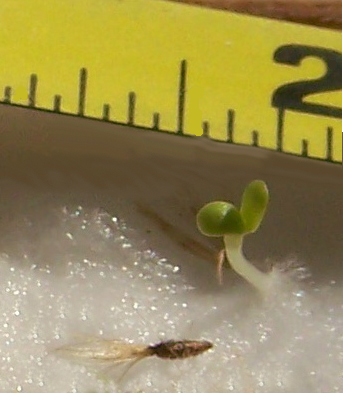
Stinkwort seed and seedling a week old,
graduation on tape measure are in 1/32nd of an inch.
--You can CHECK seeds, on moist cotton to make sure they are DEAD--You can double check that you have killed the seeds, by putting some seeds from the bottom of one of the cooked bags, and put the seeds on top of moist cotton for 10 days at room temperature, and check for any germination, which should be zero
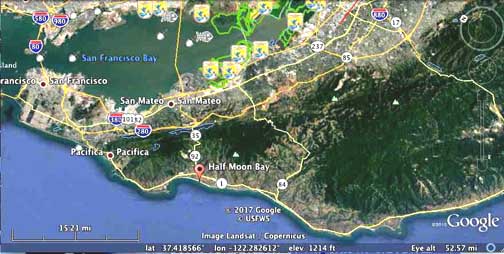
OCTOBER-DECEMBER 2017 ROADSIDE SURVEYS by Craig Dremann.
Overview of survey area, above. 26 highway and local roadsides were surveyed on the San Francisco Peninsula October-December 2017 to provide a benchmark in time, of the location and extent of the Stinkwort infestations, with a focus on San Mateo County.
Total of 310 miles, and Stinkwort was seen along 82.75 miles or about 27%. Surveys were conducted 1/4 mile by 1/4 mile, and Lat/Long coordinates down to 0.00001 degree are available for each location, except for parts of Highway One and all of Highway 17. Total of 1,241 data points.
Free to use this data, without a copyright license, only must cite the source.
SURVEY Hwy One - South
of Princeton - HERE
SURVEY Hwy 9 - From Highway
35 to Saratoga - HERE
SURVEY Hwy 35 - South
of Hwy 84 - HERE
SURVEY Hwy 85 - From Saratoga
Av. north to US 101 - HERE
SURVEY Hwy 92 - Hwy 101 to I-280 - HERE
SURVEY Hwy 92 - I-280
to Hwy One - HERE
SURVEY US 101 - Candlestick Point to Hwy 92 - HERE
SURVEY US 101 - Hwy 92 to Woodside Road - HERE
SURVEY US 101 - Woodside
Road to Lawrence Expressway - HERE
SURVEY I-280 - Hwy 92 to Sneath - HERE
SURVEY I-280 - Hwy 92 to Edgewood exit - HERE
SURVEY I-280 - Edgewood exit to Page Mill Road - HERE
SURVEY I-280 - Page Mill Road to Foothill Expressway exit - HERE
SURVEY I-280 - Foothill Expressway to WInchester Blvd. - HERE
SURVEY ALPINE ROAD - HERE
SURVEY ARASTRADERO ROAD - HERE
SURVEY CANADA ROAD - HERE
SURVEY JUNIPERO SERRA/FOOTHILL EXPRESSWAY - HERE
SURVEY LOS TRANCOS ROAD - HERE
SURVEY PAGE MILL ROAD - HERE
SURVEY SAN BRUNO MTN.-Guadalupe Parkway - HERE
SURVEY SAND HILL ROAD - HERE
SURVEY WOODSIDE
ROAD - HERE
SURVEY I-380 - HERE
SURVEY HIGHWAY 17 - HERE
SURVEY US 101 south of Hwy 87 to Hwy 152 - HERE
SURVEY Hwy 152 east of US 101 to Hwy 33 - HERE
SURVEY I-5 north from Hwy 33 - HERE
SURVEY
Start
I-5 go west to Lick Obser. Hwy 130 to Alum Rock/101 - HERE
SURVEY - DETAILS
of the TOTAL MILES - HERE
Updated January 4, 2024- The
Reveg Edge Ecological Restoration service